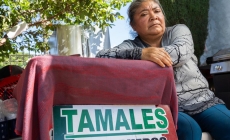-
30 hurt when car slams into crowd in Hollywood - 17 hours ago
-
Astronomer CEO Andy Byron Placed on Leave After Video at Coldplay Concert Exposes Alleged Affair - 1 day ago
-
Blood in the Streets and Death in the Air: Residents Survey Damage in Syrian City - July 17, 2025
-
Army vet calls for investigation after being detained for three days in ICE raid - July 17, 2025
-
Tariffs Push Up Prices, and the Supreme Court’s ‘Shadow Docket’ - July 16, 2025
-
ICE arrested her selling tamales at Lowes. Then she suffered a heart attack. ‘I told them: I can’t breathe’ - July 14, 2025
-
The Royal Box: Who’s in Wimbledon’s Most Exclusive Seats? - July 13, 2025
-
David Gergen, Adviser to Presidents and Political Commentator, Dies at 83 - July 12, 2025
-
Federal judge temporarily halts alleged indiscriminate immigration stops - July 12, 2025
-
Coal, the Last Survivor of Canada’s Parliament Hill Cat Colony, Dies - July 10, 2025
Man Obsessed With Online Conspiracy Theories Convicted in Paul Pelosi Attack
A jury on Thursday convicted David DePape of federal crimes for breaking into the San Francisco home of Representative Nancy Pelosi and beating her husband with a hammer in an attack that raised fears of political violence ahead of the 2022 midterm elections.
The trial lasted four days, and the jury reached its decision after deliberating for roughly eight hours. Mr. DePape, 43, faces a possible sentence of life in prison.
His lawyers did not contest the evidence against him, which included police body camera video of the attack on Paul Pelosi, 83, as well as Mr. DePape’s own admissions to the police and on the witness stand. But they argued to the jury that Mr. DePape’s bludgeoning of Mr. Pelosi while on a mission to kidnap his wife — then the speaker of the House and second in line to the presidency — did not amount to federal crimes.
They said that Mr. DePape did not act on account of Ms. Pelosi’s official duties as a member of Congress — a required element of the charges against him — but rather as part of a larger plot, fueled by online conspiracy theories, to take down a cabal of so-called liberal elites that he saw as a threat to American liberty.
If the case was never, in the words of one of Mr. DePape’s lawyers, “a whodunit,” the trial laid bare the ugliness of American politics in an age of extreme polarization.
Mr. DePape, a solitary figure who once lived under a tree in a Berkeley, Calif., park, became obsessed with right-wing conspiracy theories like Pizzagate and QAnon, and seemingly embraced the dehumanizing language about Ms. Pelosi that conservative pundits and politicians had used for years.
In the aftermath of the attack, Republican commentators and elected officials promoted more conspiracy theories about the beating, raising questions about male prostitution or simply suggesting that the official accounts of the attack were not the whole story. And some on the right mocked the beating of an octogenarian in his own home.
At a campaign rally on Saturday in New Hampshire, for example, former President J. Donald Trump called Ms. Pelosi a “crazed lunatic” to a crowd of supporters, and added: “What the hell was going on with her husband? Let’s not ask.”
In a statement released shortly after the verdict was read in court, a spokesperson for Ms. Pelosi said, “The Pelosi family is very proud of their Pop, who demonstrated extraordinary composure and courage on the night of the attack a year ago and in the courtroom this week. Thankfully, Mr. Pelosi continues to make progress in his recovery.”
The attack, in the predawn hours of Oct. 28, 2022, began with Mr. DePape busting through a back door of the Pelosi residence in the upscale Pacific Heights neighborhood of San Francisco. Inside, he discovered Mr. Pelosi asleep in his third-floor bedroom.
Standing in the doorway of the bedroom with a hammer in one hand and zip ties in another, the assailant demanded to see Ms. Pelosi, who was in Washington at the time.
“I recognized I was in serious danger,” Mr. Pelosi told the jury on Monday, in his first public comments about the attack. He added, “I tried to stay as calm as possible.”
Mr. Pelosi recounted how, with his life in jeopardy, he was able to surreptitiously call 911 from his bathroom and convey that he was in danger without aggravating Mr. DePape. When Mr. DePape said that he would wait for Ms. Pelosi to return to California but that he was tired and needed to sleep, Mr. Pelosi suggested they go downstairs, in the hope that the police were on their way.
“Why don’t we go downstairs,” Mr. Pelosi recalled saying to Mr. DePape. “And you can tie me up there and we can go to sleep.”
Shortly after, the police arrived and found Mr. DePape and Mr. Pelosi standing in the foyer, each with a hand on the hammer. When the officers demanded that they drop the weapon, Mr. DePape seized it, lunged at Mr. Pelosi and bashed him over the head. Prosecutors showed in court a photograph of Mr. Pelosi lying on the ground, a pool of blood gathering around him.
When defense lawyers began their case on Tuesday, the first witness they called was Mr. DePape himself.
Mr. DePape said the catalyst for his online radicalization was Gamergate, an online campaign that began in 2014 as a backlash against female critics of the video game industry. He said he came to Gamergate years later while living in a one-room apartment attached to a garage in Richmond, Calif., that had a fold-up futon, a large chair for playing video games and no bathroom.
Steve Bannon, the former Trump adviser, once tried to harness the community of Gamergate to connect the cadres of isolated, mostly white men to Mr. Trump’s political movement. He once told Bloomberg Businessweek, “They come in through Gamergate or whatever and then get turned on to politics and Trump.”
Mr. DePape said Gamergate awakened him to the “truth,” and from there he became a supporter of Mr. Trump and a skeptic of the mainstream media. And he came to believe in a vast conspiracy theory that liberal elites were promoting pedophilia and spreading lies about Mr. Trump.
He referred to “they” when referencing the conspiracy theory. When asked who “they” were, he responded: “The easiest answer is Wall Street, the super rich and whoever, but there is reason to believe that this traces back to the Jesuits and the Vatican and secret societies and such.”
Getting to the heart of their strategy, defense lawyers repeatedly asked Mr. DePape, who was tearful on the stand and apologized for hurting Mr. Pelosi, if he had sought out Ms. Pelosi because of her official congressional duties — such as whether she supported the Green New Deal or had said something in a floor speech or while meeting with her constituents. No, he said each time.
He targeted Ms. Pelosi, he said, because of her role as a leader of the Democrats, and her media appearances in which she pushed “lies” about Mr. Trump. Mr. DePape said he had planned to wear an inflatable unicorn costume — he brought two costumes with him on the night of the attack — while questioning Ms. Pelosi.
When he arrived at the Pelosi residence, Mr. DePape was carrying a sleeping bag and two backpacks stuffed with zip ties, a Nintendo Switch, body cameras, goji berries and $9,126 in cash, among other things — items he said he needed for his planned cross-country trip to hunt down the other targets on his list.
Among them, he said on the witness stand, were Gavin Newsom, the Democratic governor of California; the actor Tom Hanks; Hunter Biden, the son of the president; and George Soros, the hedge fund billionaire.
“He didn’t go to that house because of anything she did as speaker of the House,” Angela Chuang, a federal public defender and one of Mr. DePape’s lawyers, told the jury in her closing argument. “He went there to root out the corruption of the ruling class.”
As for Mr. Pelosi, Mr. DePape said he never intended to hurt him, and that the two had developed a “rapport” after the break-in and while Mr. DePape stood in his bedroom wielding a hammer.
“He was a very amiable gentleman,” Mr. DePape said. “And I just gave him a squeeze on the shoulder just to be reassuring.”
Mr. DePape also faces trial in state court on several felonies, including attempted murder, assault with a deadly weapon and elder abuse. The next hearing in that case is scheduled for Nov. 29, when a judge is likely to set a trial date.












